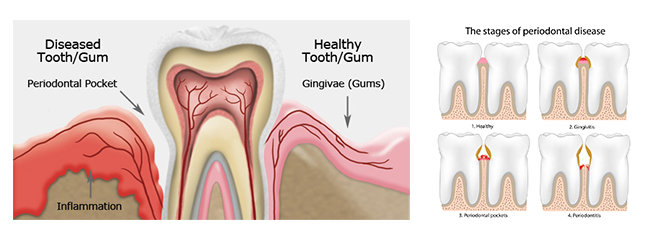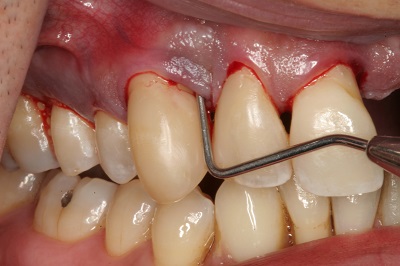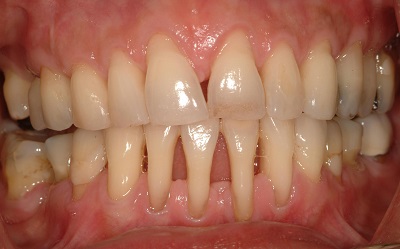Gum disease involves the gums, bone and other areas of support for teeth. Gum disease may affect any age group, but is more likely to occur in adults. Plaque that gets accumulated during these times may lead to infection and inflammation-signs of gum disease. The mildest form of gum disease is called Gingivitis. For many, Gingivitis is the most severe consequence of build-up plaque. However, some may develop a more destructive form of gum disease known as periodontitis which can be an irreversible damage to your gums and other areas supporting the teeth. It is important that your dentist assesses your condition for the above diseases and treats accordingly.

What is The Role of Plaque? Why is it so Important?
- Plaque is the major cause of gingivitis and periodontitis. It is a sticky, colorless film of bacteria that builds up on the teeth, particularly at the neck of teeth where they meet the gums. Accumulation may also occur in areas between the teeth that are difficult to clean.
- The first signs of inflammation appear, when the gums bleeds. This may be noticed during brushing or biting on a hard substance (apple).
- Bleeding and gum redness may develop slowly and usually with no pain.
- The longer the build-up of plaque occurs, the more the gums may become irritated.
- You may get worried as you see the gums bleeding, and brush that region less.
- Not brushing the areas where the gum bleeds, allows plaque to further accumulate.
- Plaque that remains on and between teeth may eventually thicken, harden and calcify to become calculus (or tartar, as it is often called).
- Calculus will trap plaque and if not removed, may result in further redness, bleeding and gum tenderness. Often, along with gum bleeding and redness, you will have bad breath and a bitter taste in your mouth upon waking in the morning. Your gums may also feel “spongy” or “soft”.
Symptoms of Gum Disease
- Bleeding Gums
- Periodontal Pocket
- Mobile Tooth
- Gums Receding With Exposure of Tooth
- Sensitivity
- Food Accumulation Between Teeth
- Swelling of Gums
- Pain in The Tooth
What are Periodontal Pockets?
Periodontal pockets are pouches where plaque has built up under the gum. They are the signs of gum disease. In severe cases the disease causes some loss of the bone supporting the teeth. Periodontal pockets are measured by a periodontal probe which has different lengths marked upon it.

Periodontal Disease and Systemic Disease
Unfortunately periodontal disease does not only affect your oral health. The increased bacterial presence in the mouth enables the bacteria to enter the blood stream, thus affecting your overall health.

Recent Studies Have Shown That Patients With Untreated Periodontal Disease are at
- 2 Times greater risk of a heart disease.
- 3 Times greater risk of a stroke.
- 7.5 Times greater risk to have premature babies with low birth weight.
- 65% Increased risk for pancreatic cancer.
The good news is that periodontal disease is treatable! Surgical treatment can be avoided especially when the disease is caught in its early stages. With proper care and maintenance. You and your teeth can have a long and healthy life.

